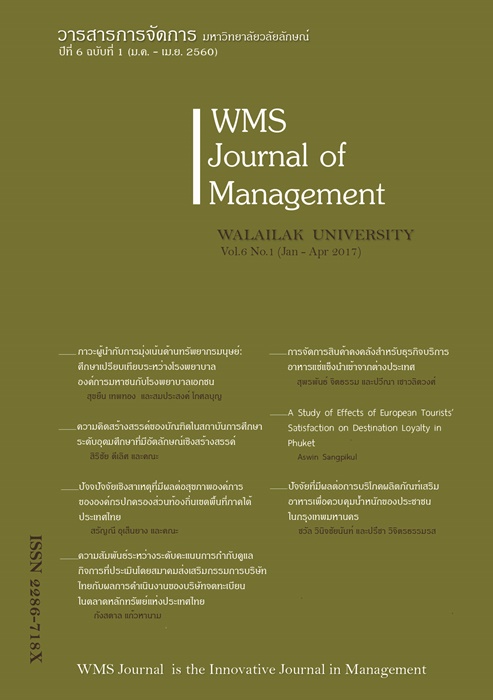A Study of Effects of European Tourists’ Satisfaction on Destination Loyalty in Phuket
Main Article Content
Abstract
Article Details
References
Alegra, J. & Garau, J. (2010). Tourist satisfaction and dissatisfaction. Annals of Tourism Research. 37(1), 52-73.
Bolton, R. & Lemon, K. (1999). A dynamic model of customers’ usage of services: Usage of an antecedent and consequence of satisfaction. Journal of Marketing Research. 36(2), 171-186.
Chi, C. & Qu, H. (2008). Examining the structural relationships of destination image, tourists, satisfaction and destination loyalty: An integrated approach. Tourism Management. 29. 624-636.
Chen, J. & Gursoy, D. (2001). An investigation of tourists’ destination loyalty and Preferences. International Journal of Contemporary Hospitality Management. 13(2), 79 – 85.
Department of Tourism. (2014). Internal Tourism 2014. Retrieved March 20, 2015 from http://www.tourism.go.th/home/details/11/221/24333
Fornell, C. (1992). A National Customer Satisfaction Barometer: The Swedish Experience. Journal of Marketing. 56, 6-21.
Hair J, Anderson R, Tatham R, Black W. 2006. Multivariate Data Analysis (6thed.). New York: Prentice-Hall International.
Heung, V. and Cheng, E. (2000). Assessing Tourists’ Satisfaction with Shopping in the Hong Kong Special Administrative Region of China. Journal of Travel Research. 38, 396-404.
Hsu, C. (2003). Mature motor-coach travelers’ satisfaction: A preliminary step toward measurement development. Journal of Hospitality and Tourism Research. 20(10), 1-19.
Hsu, C., Killion, L., Brown, G., Gross, M., & Huang. S. (2008). Tourism marketing: An Asia-Pacific perspective. Milton, Qld: John Wiley & Sons Australia.
Kim, A.K. & Brown, G. (2012). Understanding the relationships between perceived travel experiences, overall satisfaction, and destination loyalty. Anatolia – An International Journal of Tourism and Hospitality Research. 23(3), 328-347.
Kaiser H. (1974). An Index of Factorial Simplicity. Psychologist. 39(2): 31-36.
Kozak, M. and Rimmington, M. (2000). Tourist Satisfaction with Mallorca, Spain, as an Off-Season Holiday Destination. Journal of Travel Research. 38, 260-269.
Kozak, M., Bigne, E., and Andreu, L. (2004). Satisfaction and destination loyalty: A comparison between non-repeat and repeat tourists. Journal of Quality Insurance in Hospitality and Tourism. 5(1), 43-59.
Lee, G. B. (2015, June 8). Local Counsel - Support clean-up Penang drive. The Sun Daily. Retrieved from http://www.thesundaily.my/ news/1452709
Marzuki, A. (2012). Local residents’ perceptions towards economic impacts of tourism development in Phuket. TOURISM. 60(2), 199 – 212
Mechinda, P., Serirat, S., & Gulid, N. (2009). An examination of tourists’ attitudinal and behavioral loyalty: Comparison between domestic and international tourists. Journal of Vacation Marketing. 15(2), 129-148.
Mohamad, M. & Ghani, N. (2014). The impact of tourist satisfaction on destination loyalty among European tourists visiting Malaysia. International Journal of Management Sciences. 2(8), 362-371.
Nurhayati, D. (2011, July 2). Movement to address acute waste problems in Bali launched. Jakrata Post. Retrieved from http://www.thejakartapost.com/news/2011/07/02/ movementaddress-acute-waste-problems-bali-launched.html-0
Panitcharemkit, D. (2013). Local creative tourism: A case study on Phuket. Journal of US-China Public Administration. 10(3), 303-309.
Polnyotee, M. & Thadaniti, S. (2014). The survey of factors influencing sustainable tourism at Patong beach, Phuket island, Thailand. Mediterranean Journal of Social Sciences. 5(9), 650-655.
Rahman, M K. (2014). Motivating factors of Islamic tourists’ destination loyalty: an empirical investigation in Malaysia. Journal of Tourism and Hospitality Management. 2(1), 63-77.
Reisinger, Y. & Turner, L.W. (2003). Cross-cultural behavior in tourism: Concepts and analysis. Oxford: Butterworth-Heinermann.
Thongkundam, P. & Promsivapallop, P. (2012). Australian and Russian tourists’ perception of Phuket’s destination image. Conference proccedding of the first Annual PSU Phuket International Conference. 10 January 2013. Prince of Songkla University, Phuket campus.
Toyama, M. & Yamada, Y. (2012). The relationships among tourist novelty, familiarity, satisfaction and destination loyalty: Beyond the novelty-familarity continuum. International Journal of Marketing Studies. 4(6), 10-18.
Valle, P. O., Silva, J. A., Mendes, J. & Guerreiro, M. (2006). Tourist satisfaction and destination loyalty intention: A structural and categorical analysis. International Journal of Business Science and Applied Management. 1(1), 25-44.
Williams, T., Sweeney, D., and Anderson, D. (2006). Contemporary Business Statistics. Thomson South-Western, USA.
Yoon, Y. and Uysal, M. (2005). An Examination of the Effects of Motivational and Satisfaction on Destination Loyalty: A Structural Model. Tourism Management. 26, 45-56.


